Advanced Technology for Wind Power Generation
Introductory Video of Wind Power Team
 "Forecasting the Wind to Improve Efficiency of Wind Power Generation"
"Forecasting the Wind to Improve Efficiency of Wind Power Generation"
Advanced Technology for Wind Power Generation
[ YouTube 3'30 ]
Overview
In order to accelerate the introduction of wind power generation and achieve grid parity it is necessary to reduce the cost of wind power generation. This requires the continuous development of the hardware aspect of wind turbine technology, and the software aspect of technologies for the selection of suitable sites and management of wind farms.
Research Target
The team aims to establish elemental technologies for a high-performance wind turbine and its control strategies, and wind assessment technologies for the site selection and operation of wind farms, in cooperation with the domestic wind power industry.
These technologies will help reduce the cost of wind power generation, stimulate the domestic market, and improve the international competitiveness of the wind power industry in Japan.
The team has set the following goals:
- Improvement of the power output by 5% or more and the lifetime of wind turbines by 5‒10% or more by developing elemental technologies for improving the performance of wind turbines and entire wind farms.
- Advancement of assessment technologies for accurate wind measurements with errors of less than ±5% in annual wind speed and the reduction of assessment costs by 20‒30%.
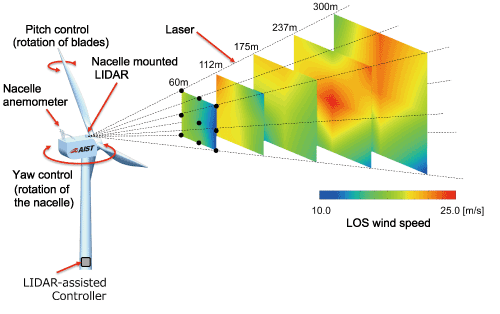 【Fig. 1】Line of sight (LOS) wind speed at an upwind distance of 75-300 min front of the turbine measured by a nacelle-mounted LIDAR installed on a research wind turbine.
【Fig. 1】Line of sight (LOS) wind speed at an upwind distance of 75-300 min front of the turbine measured by a nacelle-mounted LIDAR installed on a research wind turbine.
* LIDAR: Light Detection and Ranging(Device for remotely measuring wind speed and direction by laser light)
Research Outline
Elemental technology for a high-performance wind turbine
Based on the upwind wind speed and direction measured by a prototype of nacelle-mounted LIDAR, feed-forward control is investigated to improve the power output and to alleviate fatigue loads on the blade, drivetrain and tower coming from wind gusts and wind shear during operation. Furthermore, innovative plasma aerodynamic control technology is also investigated to improve the turbine performance. Atmospheric plasma is generated on the electrodes attached to the blade surface by high voltage activation. These technologies are demonstrated by the research wind turbine.
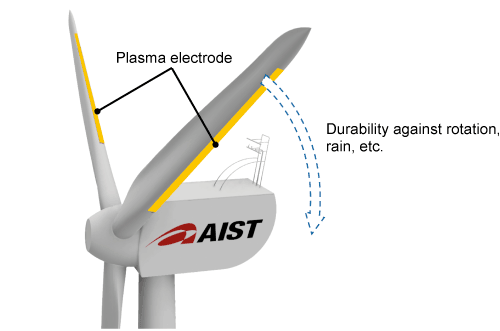 【Fig. 2】Performance improvement by plasma aerodynamic control
【Fig. 2】Performance improvement by plasma aerodynamic control
Wind resource assessment using new technologies
In-situ offshore wind measurements using meteorological masts are economically difficult, except for the purpose of demonstration research project. Instead of using meteorological masts, we are developing wind resource assessment technologies using LiDAR measurements, satellite remote sensing and meteorological model simulations. These advanced methods will realize cost reduction for wind resource assessment, while keeping reliability and accuracy.
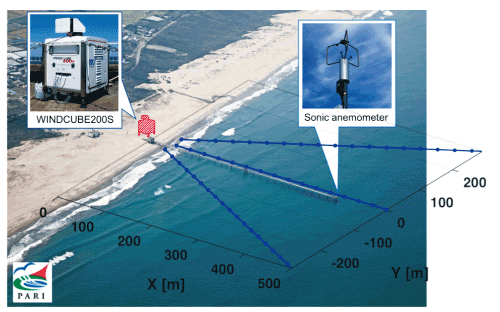 【Fig. 3】Field experiments at the Hazaki Oceanographical Research Station
【Fig. 3】Field experiments at the Hazaki Oceanographical Research Station
Main Research Facilities
【Fig. 4】Research wind turbine Komaihaltec Inc. KWT300
Rated power output: 300 kW, rotor diameter: 33 m, hub height: 41.5 m.
The wind turbine is designed to withstand severe climate conditions in Japan (e.g. a highly turbulent flow from the complex terrain) through the collaborative research of AIST and Komaihaltec Inc.
【Fig. 5】Prototype of the nacelle-mounted LIDAR
The forward-looking wind LIDAR measures the approaching inflow in front of the research wind turbine with nine sampling directions.
【Fig. 6】Satellite and meteorological data processing system
The system provides about 1 petabyte of storage for large-scale satellite and meteorological data, and it also processes the data.
【Fig. 7】Environmental exposure test field for plasma electrode
The apparatus evaluates the weatherability of plasma electrode by exposing it over a long period in the environment used outdoor environment.
【Fig. 8】Scanning LIDAR
The device observes wind speeds at several km away with sampling rate of several seconds by detecting the doppler shift of laser.
【Fig. 9】Search device for acoustic sources
The system surveys acoustic sources using 30 acoustic microphones and transducers.
【Fig. 10】Test field for calibration of remote sensing device
Activities and Achievements
Result demonstration results of the nacelle-mounted LIDAR (Fig. 11)
The yaw control of wind turbine is assisted using the upwind wind direction information measured by the nacelle mounted LIDAR. As a result, the power output is improved 5% at maximum.
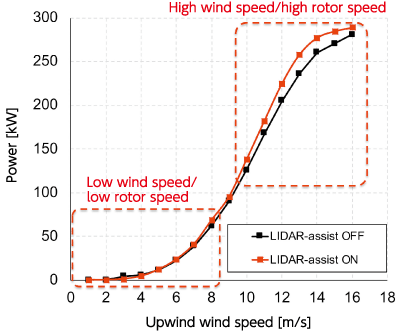 【Fig. 11】
【Fig. 11】
Performance improvement by plasma aerodynamic control (Fig. 12)
The improvement of flow around airfoil by plasma flow control has been demonstrated by laboratory experiments, but not by field experiments with an actual wind turbine. We are demonstrating the effects by field experiments and evaluating the durability of the electrodes to accelerate commercialization of this technology.
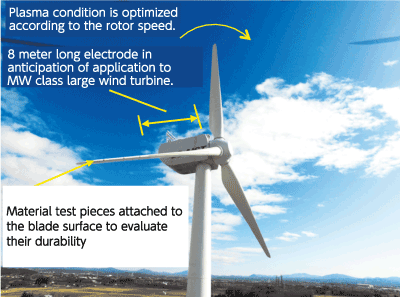 【Fig. 12】
【Fig. 12】
Wind resource assessment using new technology (Making a new offshore wind atlas)
The new NEDO offshore wind atlas (NeoWins)※ was created based on meteorological model simulations with a 500m grid resolution using a super computer system and a satellite observation of the Advanced Scatterometer (ASCAT) data.
The new wind atlas has been opened since 2016. In the NeoWins project, we achieved an accuracy target of ±5% in annual mean wind speed at a wind turbine hub height, by applying results obtained from previous our objective basic researches such as Shimada et al. (2015), which is a study on an accurate and high-resolution Sea Surface Temperature dataset for mesoscale modeling.
※NEDO PJ Contractors: AIST, Kobe university, Asia Air Survey Co.,LTD. and Wind Energy Institute of Tokyo Inc.
Team Member
| Title |
Name |
| Leader |
KOGAKI Tetsuya |
| Senior Researcher |
TANAKA Motofumi |
| Senior Researcher |
KAWABATA Hirokazu |
| Senior Researcher |
SHIMADA Susumu |
| Researcher |
KUBO Noritsugu |
| Researcher |
AIHARA Aya |
| - |
MORIKAWA Yasushi |